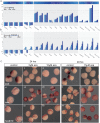Anteroposterior axis patterning by early canonical Wnt signaling during hemichordate development
- PMID: 29337984
- PMCID: PMC5786327
- DOI: 10.1371/journal.pbio.2003698
Anteroposterior axis patterning by early canonical Wnt signaling during hemichordate development
Abstract
The Wnt family of secreted proteins has been proposed to play a conserved role in early specification of the bilaterian anteroposterior (A/P) axis. This hypothesis is based predominantly on data from vertebrate embryogenesis as well as planarian regeneration and homeostasis, indicating that canonical Wnt (cWnt) signaling endows cells with positional information along the A/P axis. Outside of these phyla, there is strong support for a conserved role of cWnt signaling in the repression of anterior fates, but little comparative support for a conserved role in promotion of posterior fates. We further test the hypothesis by investigating the role of cWnt signaling during early patterning along the A/P axis of the hemichordate Saccoglossus kowalevskii. We have cloned and investigated the expression of the complete Wnt ligand and Frizzled receptor complement of S. kowalevskii during early development along with many secreted Wnt modifiers. Eleven of the 13 Wnt ligands are ectodermally expressed in overlapping domains, predominantly in the posterior, and Wnt antagonists are localized predominantly to the anterior ectoderm in a pattern reminiscent of their distribution in vertebrate embryos. Overexpression and knockdown experiments, in combination with embryological manipulations, establish the importance of cWnt signaling for repression of anterior fates and activation of mid-axial ectodermal fates during the early development of S. kowalevskii. However, surprisingly, terminal posterior fates, defined by posterior Hox genes, are unresponsive to manipulation of cWnt levels during the early establishment of the A/P axis at late blastula and early gastrula. We establish experimental support for a conserved role of Wnt signaling in the early specification of the A/P axis during deuterostome body plan diversification, and further build support for an ancestral role of this pathway in early evolution of the bilaterian A/P axis. We find strong support for a role of cWnt in suppression of anterior fates and promotion of mid-axial fates, but we find no evidence that cWnt signaling plays a role in the early specification of the most posterior axial fates in S. kowalevskii. This posterior autonomy may be a conserved feature of early deuterostome axis specification.
Conflict of interest statement
The authors have declared that no competing interests exist.
Figures











References
-
- Logan CY, Nusse R. The Wnt signaling pathway in development and disease. Annu Rev Cell Dev Biol. 2004;20:781–810. doi: 10.1146/annurev.cellbio.20.010403.113126 . - DOI - PubMed
-
- MacDonald BT, Tamai K, He X. Wnt/beta-catenin signaling: components, mechanisms, and diseases. Developmental cell. 2009;17(1):9–26. Epub 2009/07/22. doi: 10.1016/j.devcel.2009.06.016 . - DOI - PMC - PubMed
-
- Adamska M, Degnan SM, Green KM, Adamski M, Craigie A, Larroux C, et al. Wnt and TGF-beta Expression in the Sponge Amphimedon queenslandica and the Origin of Metazoan Embryonic Patterning. PloS one. 2007;2(10):e1031 doi: 10.1371/journal.pone.0001031 . - DOI - PMC - PubMed
-
- Adamska M, Larroux C, Adamski M, Green K, Lovas E, Koop D, et al. Structure and expression of conserved Wnt pathway components in the demosponge Amphimedon queenslandica. Evolution & development. 2010;12(5):494–518. Epub 2010/10/05. doi: 10.1111/j.1525-142X.2010.00435.x . - DOI - PubMed
-
- Kusserow A, Pang K, Sturm C, Hrouda M, Lentfer J, Schmidt HA, et al. Unexpected complexity of the Wnt gene family in a sea anemone. Nature. 2005;433(7022):156–60. doi: 10.1038/nature03158 . - DOI - PubMed
Publication types
MeSH terms
Substances
Grants and funding
LinkOut - more resources
Full Text Sources
Other Literature Sources

